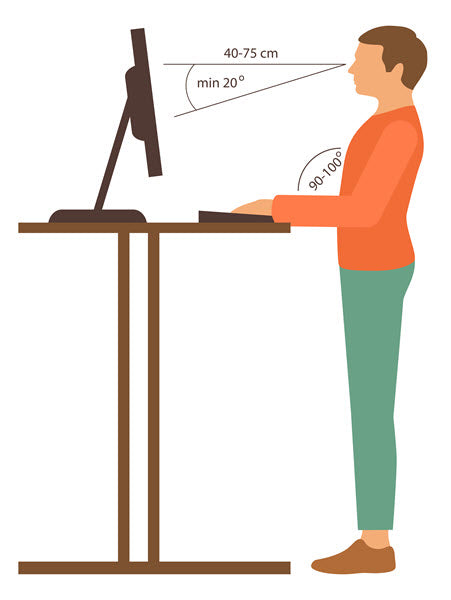
Once you’ve chosen a standing desk, the setting the height of your monitor, keyboard, and desktop is really important. The desks you are considering need to work for your height and it helps you know where to set it when you are getting started, and this calculator will help. Once you’ve used the desk awhile and are comfortable you’ll know where to set your desk once you have trained your body to stand with good posture. But until that happens, use these guidelines as a calculator to determine the height of your desk, chair, and other items in your workstation.
- When your workstation is set optimally for your body and particular work, this can help prevent occupational diseases such as musculoskeletal disorders (MSDs), and alleviate symptoms should you have them.
- MSDs account for a significant portion of lost time claims. Fortunately, most workplace risk factors that cause MSDs, can be identified and eliminated through ergonomic interventions.
- You want to attempt to reduce the likelihood of MSDs by having this easy-to-use calculator, so you can adjust your workstation according to your individual body measurements and needs.
How to Calculate Desk Height

First, we have some tips for using the ergonomic calculator, so you know you’re using your ergonomic furniture and accessories optimally.
- Always keep in mind your shoe height and make allowances for the clothing you wear regularly
- If you use bifocal lenses, you may need to lower the height of monitors
- You’re going to change your posture throughout the day so make sure you adjust your workstation each time
- Your posture will change more often standing than sitting
- Change the positioning of any of your equipment the moment you begin to feel and discomfort
The proper desk height and monitor position are crucial for your comfort and preventing potential musculoskeletal harm. Your standing desk should be elbow height; meaning your elbows should be in a 90-degree position from the floor. The recommended setting is to have your monitor 20 – 28 inches from your face—the distance should be no less than from the tip of your middle finger to your elbow.
Your Office Chair
Serving to support your back, reduce pressure on the back of your knees, and support your upper and lower limbs for hours at a time, your desk chair is quite important. However, if your chair is not adjusted correctly according to its specifications and your body, it can cause physical harm to you. The following conditions have been observed in office workers with an inadequate chair or chair setup:
- Edema – fluid retention and swelling of the calves, ankles, and feet
- Sensation of numbness, tingling, or cold feet
- Lower back strain, stress, or pain
If you don’t know how to adjust your chair correctly, having an ergonomic one won’t prevent or relieve MSDs. Proper posture, induced by correct seat positioning, promotes overall comfort, increases concentration, and leads to greater endurance through long hours of seated work.
How to Calculate Chair Height

The following should be taken into account when you are determining your office chair height.
- Your chair height should keep your elbows at desktop level.
- Your chair should support your lower back securely, use a lumbar pillow if needed.
- You’ll want to look for a chair that allows you to adjust the height of the seat so that your knees are either level or just below level, and your feet are squarely on the floor. The lever or knob to adjust the seat height should be easy to reach and use while you’re sitting in the chair.
- If there’s pressure on the back of your knees or legs or your feet, don’t sit them flat on the floor. Either use a footrest or lower your keyboard.
- The viewing area of your monitor should be slightly below eye level (so make sure this is how your monitor is situated).
- Your wrists should be straight when they’re at desk level. Adjust armrests try to adjust them so they support your arms without being too high or too low, using small pads on armrests if those on the chair are inadequate. Use a wrist rest if you feel you need one.
- Keep your mouse right next to your keyboard so both elbows are by your sides while working. Avoid pressing your hands or forearms against any sharp edges on desk. Use your mouse pad or another soft surface to pad edge of desk.
- Because we don’t all come in the same size, the width of the chair should be an inch or two wider than your thighs and hips when you’re seated. Choose a chair with a seat depth that ends an inch or two behind your knees, preferably with a waterfall front.
- You can find a variety of back sizes and heights, from chairs that provide lumbar support only, to taller chairs with headrests. The back of the chair shouldn’t be so large that you can’t move your elbows behind your torso.
- You can find many chairs with lumbar supports that are adjustable both up and down as well as forward and backward to best fit your body. Chairs with adjustable lumbar support are especially important if more than one person will use the chair.

